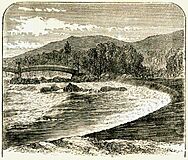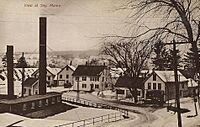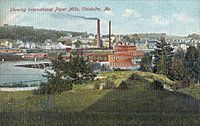Jay, Maine facts for kids
Quick facts for kids
Jay, Maine
|
|
|---|---|

Holmes-Crafts Homestead is now a museum maintained by the Jay Historical Society
|
|
| Motto(s):
"Proud of our past...Working for our future"
|
|
| Country | United States |
| State | Maine |
| County | Franklin |
| Incorporated | 1795 |
| Villages |
|
| Area | |
| • Total | 49.20 sq mi (127.43 km2) |
| • Land | 48.38 sq mi (125.30 km2) |
| • Water | 0.82 sq mi (2.12 km2) |
| Elevation | 653 ft (199 m) |
| Population
(2020)
|
|
| • Total | 4,620 |
| • Density | 96/sq mi (36.9/km2) |
| Time zone | UTC−5 (Eastern (EST)) |
| • Summer (DST) | UTC−4 (EDT) |
| ZIP Codes |
04239 (Jay)
04262 (North Jay) |
| Area code(s) | 207 |
| FIPS code | 23-35625 |
| GNIS feature ID | 0582534 |
Jay is a small town located in Franklin County, Maine, United States. It's part of the wider Lewiston-Auburn area. In 2020, about 4,620 people lived here. The town also includes the village of Chisholm.
Contents
History of Jay, Maine
Early Days and Naming
Long ago, this area was home to the Anasagunticook (or Androscoggin) Abenaki Indians. Sadly, many of them died from smallpox in 1757.
Later, the land was given to Captain Joseph Phipps and 63 other people. This was a reward for their help in the French and Indian War. The area was first called Phipps-Canada. People didn't start settling here until after the Revolutionary War.
On February 26, 1795, Phipps-Canada officially became a town and was named Jay. It was named after John Jay, who was the very first chief justice of the Supreme Court.
Changes in County and Land
Jay was first part of Cumberland County. Then, in 1805, it became part of Oxford County. Finally, in 1838, it joined Franklin County, where it is today. In 1821, a part of Jay was separated to form the town of Canton.
Farming and Early Businesses
The soil in Jay was very good for farming. Farmers grew lots of hay, corn, wheat, potatoes, oats, and apples.
Over time, more businesses started in Jay:
- In 1793, a tavern (like an inn or restaurant) was built at Jay Hill.
- A toll bridge was built over the Androscoggin River.
- In 1839, a sawmill was built.
- At North Jay, there was another sawmill, a brickyard, and a granite quarry.
The white granite from the North Jay Granite Company became very famous. It was used to build important buildings across the country, including Grant's Tomb. East Jay also had a sawmill, and Bean's Corner had a factory that made carriages. In 1857, the Maine Central Railroad came to town, making it easier to transport goods.
The Rise of Paper Mills
After 1870, making paper became the biggest industry in Jay.
- In 1888, a man named Hugh J. Chisholm built the Otis Falls Pulp & Paper Company mill. It was the third largest paper mill in the country!
- A new village called Chisholm grew up around this mill.
- In 1898, this mill became part of a big company called International Paper.
- Another mill, known as the Otis mill, was built in 1905. It closed in 2009.
- In 1965, International Paper opened the Androscoggin Mill. This mill makes both pulp and finished paper products. It employed many people.
- In 1987-1988, there was a disagreement between the workers and International Paper. This led to the company hiring new workers.
- On April 15, 2020, there was an explosion at the Androscoggin Mill. It caused damage to two trucks from falling pieces.
Natural Resources
Jay has many trees, like most towns in Maine. But it's also known for its large deposits of granite, especially white granite. This special granite from Jay has been used in buildings and projects all over the country.
Geography of Jay
Jay covers about 49.20 square miles (127.43 square kilometers). Most of this area is land (about 48.38 square miles or 125.30 square kilometers), and a small part is water (about 0.82 square miles or 2.12 square kilometers). The town gets its water from Seven Mile Stream and the Androscoggin River.
Several state roads pass through Jay, including Route 4, 17, 133, 140, and 156. Jay is surrounded by other towns:
- To the north: Wilton
- To the east: Chesterville
- To the south: Livermore and Livermore Falls
- To the west: Canton and Dixfield
Population Data
| Historical population | |||
|---|---|---|---|
| Census | Pop. | %± | |
| 1800 | 430 | — | |
| 1810 | 1,107 | 157.4% | |
| 1820 | 1,614 | 45.8% | |
| 1830 | 1,276 | −20.9% | |
| 1840 | 1,750 | 37.1% | |
| 1850 | 1,733 | −1.0% | |
| 1860 | 1,680 | −3.1% | |
| 1870 | 1,490 | −11.3% | |
| 1880 | 1,291 | −13.4% | |
| 1890 | 1,541 | 19.4% | |
| 1900 | 2,758 | 79.0% | |
| 1910 | 2,987 | 8.3% | |
| 1920 | 3,152 | 5.5% | |
| 1930 | 3,106 | −1.5% | |
| 1940 | 2,858 | −8.0% | |
| 1950 | 3,102 | 8.5% | |
| 1960 | 3,247 | 4.7% | |
| 1970 | 3,954 | 21.8% | |
| 1980 | 5,080 | 28.5% | |
| 1990 | 5,080 | 0.0% | |
| 2000 | 4,985 | −1.9% | |
| 2010 | 4,851 | −2.7% | |
| 2020 | 4,620 | −4.8% | |
| U.S. Decennial Census | |||
Jay's Population in 2010
In 2010, there were 4,851 people living in Jay. Most residents (98.1%) were White. About 22.1% of the people were under 18 years old. The average age in town was about 43 years old.
Places to Visit
- Holmes-Crafts Homestead
Education in Jay
The Jay School Department used to manage the schools in town. It had one elementary, one middle, and one high school. In 2010, about 700 students attended these schools.
Jay's Schools Over Time
- Jay Elementary School: This school was built in the mid-1960s and was updated in 2018. It taught students from Pre-K to 3rd grade.
- Jay Middle School: Finished in 1997, this was the newest school in the district. It taught grades 4-8. It even connected to the Jay Community Building, where town meetings and voting happened.
- Jay High School: Opened in 1970, this school taught grades 9-12. It had a unique round gym, once called The Tiger Dome, named after the school's mascot, the Tigers.
Joining Forces: RSU 73
In 2010, the Jay schools joined with schools from Livermore and Livermore Falls. They formed a new school district called RSU 73.
- Jay High School and Livermore Falls High School were renamed Spruce Mountain High School North and South campuses.
- The old mascots, the Tigers and Andies, were replaced by the Spruce Mountain Phoenix. This new mascot symbolized the schools being "reborn" as one.
- Livermore Falls Middle School closed, and its students moved to the new Spruce Mountain Middle School, which was at the former Jay Middle School building.
Eventually, all high school students moved to the North Campus. This meant some classrooms had to be divided to fit more students. The first class to go through all four years at the combined Spruce Mountain High School graduated in 2016.
Notable People from Jay
- Franklin W. Johnson: He was the president of Colby College from 1929 to 1942.
- Edwin Thompson: He was the head coach for the baseball team at Georgetown University.
Gallery
See also
 In Spanish: Jay (Maine) para niños
In Spanish: Jay (Maine) para niños






